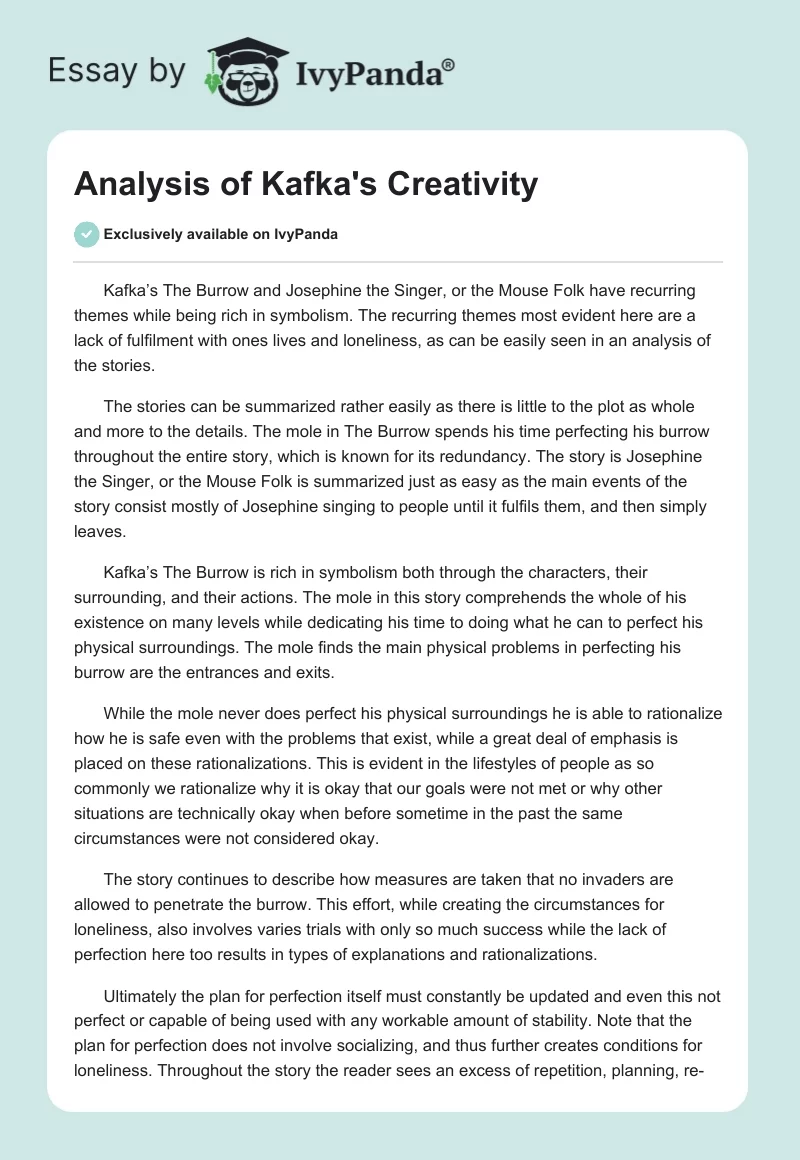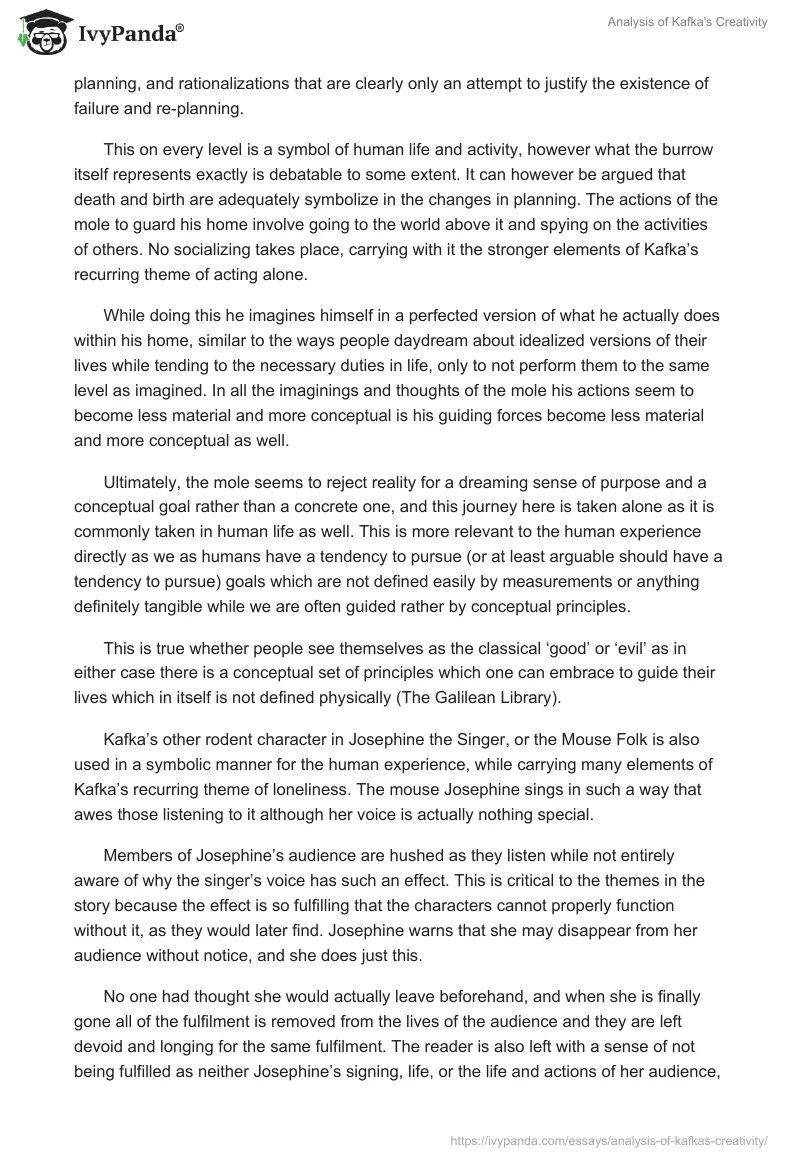Kafka’s The Burrow and Josephine the Singer, or the Mouse Folk have recurring themes while being rich in symbolism. The recurring themes most evident here are a lack of fulfilment with ones lives and loneliness, as can be easily seen in an analysis of the stories.
The stories can be summarized rather easily as there is little to the plot as whole and more to the details. The mole in The Burrow spends his time perfecting his burrow throughout the entire story, which is known for its redundancy. The story is Josephine the Singer, or the Mouse Folk is summarized just as easy as the main events of the story consist mostly of Josephine singing to people until it fulfils them, and then simply leaves.
Kafka’s The Burrow is rich in symbolism both through the characters, their surrounding, and their actions. The mole in this story comprehends the whole of his existence on many levels while dedicating his time to doing what he can to perfect his physical surroundings. The mole finds the main physical problems in perfecting his burrow are the entrances and exits.
While the mole never does perfect his physical surroundings he is able to rationalize how he is safe even with the problems that exist, while a great deal of emphasis is placed on these rationalizations. This is evident in the lifestyles of people as so commonly we rationalize why it is okay that our goals were not met or why other situations are technically okay when before sometime in the past the same circumstances were not considered okay.
The story continues to describe how measures are taken that no invaders are allowed to penetrate the burrow. This effort, while creating the circumstances for loneliness, also involves varies trials with only so much success while the lack of perfection here too results in types of explanations and rationalizations.
Ultimately the plan for perfection itself must constantly be updated and even this not perfect or capable of being used with any workable amount of stability. Note that the plan for perfection does not involve socializing, and thus further creates conditions for loneliness. Throughout the story the reader sees an excess of repetition, planning, re-planning, and rationalizations that are clearly only an attempt to justify the existence of failure and re-planning.
This on every level is a symbol of human life and activity, however what the burrow itself represents exactly is debatable to some extent. It can however be argued that death and birth are adequately symbolize in the changes in planning. The actions of the mole to guard his home involve going to the world above it and spying on the activities of others. No socializing takes place, carrying with it the stronger elements of Kafka’s recurring theme of acting alone.
While doing this he imagines himself in a perfected version of what he actually does within his home, similar to the ways people daydream about idealized versions of their lives while tending to the necessary duties in life, only to not perform them to the same level as imagined. In all the imaginings and thoughts of the mole his actions seem to become less material and more conceptual is his guiding forces become less material and more conceptual as well.
Ultimately, the mole seems to reject reality for a dreaming sense of purpose and a conceptual goal rather than a concrete one, and this journey here is taken alone as it is commonly taken in human life as well. This is more relevant to the human experience directly as we as humans have a tendency to pursue (or at least arguable should have a tendency to pursue) goals which are not defined easily by measurements or anything definitely tangible while we are often guided rather by conceptual principles.
This is true whether people see themselves as the classical ‘good’ or ‘evil’ as in either case there is a conceptual set of principles which one can embrace to guide their lives which in itself is not defined physically (The Galilean Library).
Kafka’s other rodent character in Josephine the Singer, or the Mouse Folk is also used in a symbolic manner for the human experience, while carrying many elements of Kafka’s recurring theme of loneliness. The mouse Josephine sings in such a way that awes those listening to it although her voice is actually nothing special.
Members of Josephine’s audience are hushed as they listen while not entirely aware of why the singer’s voice has such an effect. This is critical to the themes in the story because the effect is so fulfilling that the characters cannot properly function without it, as they would later find. Josephine warns that she may disappear from her audience without notice, and she does just this.
No one had thought she would actually leave beforehand, and when she is finally gone all of the fulfilment is removed from the lives of the audience and they are left devoid and longing for the same fulfilment. The reader is also left with a sense of not being fulfilled as neither Josephine’s signing, life, or the life and actions of her audience, nor the meaning of the story as a whole is as clear as the reader would likely prefer it to be (PD Smith).
It would appear that Kafka is trying to portray the evil that has resulted in the evolution of society, furthermore implying that people are unaware of it due to its source. Kafka implies the development of modern culture and an institutionalization effect account for most of this, as do all other closely related areas.
Both of these books attempt to exploit the flaws in culture through their various means. The Burrow better depicts Kafka’s societal views better than Josephine the Singer, or the Mouse Folk; the latter is more personal and cultural than on the larger scale concerned with society as a whole.
It would appear that Kafka himself experienced a number of these circumstances as they are so personal. Kafka appears to have a serious care for the general survival of man and the modern world, despite Kafka’s blaming of men’s problems on the structure of the modern world. In this, perhaps there is a better way for the world to develop without infringing on the emotions and natural processes of people.
Without such a change, Kafka implies we should worry for our freedom and rights as citizens, for the corrupt forces in society may very well become too powerful. One should not take the actions of the main character and live in isolation, as this caters to the degenerative effect.
Kafka has obvious issues with the norms in society, while urging the reader to consider their own lives with regards to the unnatural and potentially inhumane ways which are becoming more commonplace. The anxiety which occurs in both stories reveal how it is counterproductive to the human experience, while certain lifestyles considered normal by society ultimately leave people empty or preoccupied with something unfulfilling.
Family is also somewhat of a theme in Kafka’s writing, a solution to the problems in The Burrow, and manufactured as a solution to the emotional problems of the characters in Josephine the Singer, or the Mouse Folk. She is loved, honoured, guarded, and esteemed, similar to how family members are treated.
Despite this treatment, Josephine ultimately feels alone because no one is actually like her. She has nothing in common with the people in the village both as far as talent and mentality. She is also seen as different since she can sing, while she is initially respected and loved as family, her status soon puts her deeper into her own sense of isolation, similar to the character in The Burrow.
While Kafka is likely not ‘technically’ an existentialist, he does have many qualities of one. His philosophy is not especially deep, however considered the setting and the details of the stories, Kafka resembles an existentialist. His themes are simple, although reveal a number of complex notions and relationships.
Kafka does not explicitly teach and lessons in his stories while he merely exploits notions in culture, and eventually his characters. The reader is to draw upon this what they will, and while there are several direct implications in each story, the classic ‘moral of the story’ or any solid lesson in the classical sense is not evident in either case.
Neither of his stories are particularly long either, though this would have had a significant impact on how lessons are conveyed. Kafka performs well in estimating the limit for emotion and feeling within the tales while effectively making changes at the emotional limits.
Kafka implies that law is becoming as corrupt as the rest of institutions in society, though this is not as immediately evident as his other themes. Overall it is clear that Kafka has become dissatisfied with the way the world has become and is calling for a change. Not an extremist, Kafka’s stories suggest that the changes that take place involve more of the mind first, followed by the processes in society.
The characters reveal how people are seeking means to give purpose to life which are unfulfilling, and that this should be changed both through self and society. How this can or should be done is not directly stated, however the problems that are arising in this manner are the basis for Kafka’s tales.


